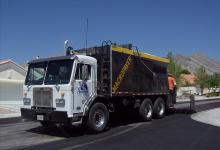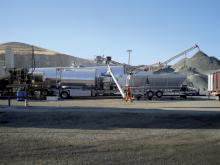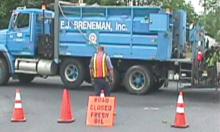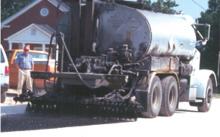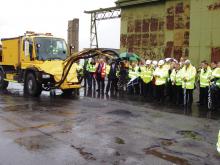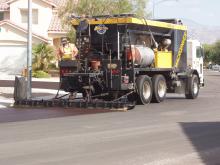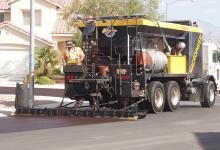Highway maintenance and repair is an easy target for cuts in highway budgets, but there are cost-effective measures that can be adopted as Patrick Smith reports
Highway maintenance and repair is an easy target for cuts in highway budgets, but there are cost-effective measures that can be adopted as Patrick Smith reports
Road maintenance is an increasingly important industry that spans a worldwide market. Awareness of the need for a stable and sustainable international infrastructure, maintenance and creative rural road technologies are taking a stronger role as viable sources for a cost-effective means of preserving, developing and prolonging the life of roads without expensive reconstruction, says US-based VSS (Valley Slurry Seal).With tightening highway construction and maintenance budgets worldwide, many authorities are seeking ways of making the money they have go further.
Only recently, Philip Hoare, new chairman of the UK's Highways Term Maintenance Association (HTMA), committed the organisation to further improving the quality of highways management and maintenance in a bid to reinforce the message that reliable and safe roads are paramount to the social and economic needs of the nation.
HTMA is a group of 21 contracting and consulting companies including major international names such as
"We are facing unprecedented times of austerity with spending cuts and we must work with our client organisations and colleagues across the industry to face this challenge while minimising the impact on front line customer services," said Hoare.
Outgoing, HTMA chairman, Mike Notman, PFI [Private Finance Initiative] project director at public services provider Amey, warned: "Highways maintenance is an easy target. Capital schemes such as safety improvements, congestion management and highway improvements can simply be slashed from the budget to make savings in the short-term. But this can be a false economy as the long-term costs are greater." Such matters are sure to be discussed at the upcoming World Congress on Emulsions (12-14 October, 2010 in Lyon, France), which will be preceded on 11 October by the fifth
In an editorial, Jean Claude Roffé, President, IBEF (International Bitumen Emulsion Fédération) asks what has happened since the last meeting in 2006.
"A major economic crisis has impacted the road industry, leading to drastic cuts in budgets earmarked for road networks, and in particular, funds set aside for maintenance of existing roadways.
"Environmental protection has been confirmed as a leading concern, to which one can add new targets: reducing energy consumption and CO2 emissions and saving non-renewable resources," he says.
"All of this has led the bitumen emulsion industry to refocus their products and their marketing policies on sustainable - or responsible - development.
"By highlighting the pertinence and the interest of emulsion-based techniques designed to preserve existing networks, the demands of sustainable development criteria represent a genuine opportunity for our industry.
"Because the members of the IBEF account for 80% of the world's bitumen emulsion production, national associations will be called upon to contribute to each theme." Meanwhile, VSS says that agencies and local governments are utilising preservation techniques more often in order to increase safety of the roads and to cut costs during trying economic times.
There are a variety of systems that can be used to achieve this such as slurry seals, micro-surfacing [an advanced form of slurry seal], Macro-surfacing, chip seal and Cape seal to extend a road's life sometimes by seven years or more. According to VSS, a preventative slurry seal can be 30-50% of the cost of other treatments.
A slurry seal emulsion is a mixture of well-graded fine aggregate, mineral filler (if needed), emulsified asphalt and water, applied to a pavement as a surface treatment usually applied in a thickness of 3-6mm.
It is used in both the preventive and corrective maintenance of asphalt pavement surfaces, but is not intended to increase the structural strength of a pavement section. If there is damage it has to be rectified first.
"Slurry seal and micro-surfacing are among the most efficient methods of preventive maintenance for highways, roads and parking lots worldwide," says Bergkamp, which designs and manufactures asphalt pavement preservation equipment, and which offers its M1 self-propelled continuous slurry seal and micro-surfacing paver.
Proponents of systems such as slurry seals (and there are many) point to its advantages: it can be quickly applied; there is no loose cover aggregate; it seals surface cracks, stops ravelling and loss of matrix and makes open surfaces impermeable to air and water, while improving skid resistance.
"Slurry Seals come in many different types. Different stone sizes give different surface textures. Type I is fine and is for parking lots and runways. Type II is coarser and general purpose it is used for all applications including arterial roads, residential areas and highways. Type III is the coarsest and is used on freeways and high-speed roads and industrial estates," says VSS.
"Different types of aggregate will give lighter or darker results, and the famous Table Mountain black rock will give surfacing that new look all through its life." Slurry seals can be polymer modified for longer wear and better resistance to traffic and cracking. This modification includes latex rubber, crumb rubber and other polymers.
Slurry is mixed in a travelling paver truck. The exact proportions determined in a laboratory mix design (and in the case of VSS) are mixed in a pugmill controlled by the advanced electronics and hydraulics of its Macropaver machine, which it designs and builds. The seal is laid through a specially-designed spreader box.
Indeed, three VSS 12B Macropaver machines were among the equipment used by American Pavement Preservation on an award-winning contract in Las Vegas, Nevada, which is understood to be the largest slurry seal project ever completed by a contractor in the United States.
Presented by the International Slurry Surfacing Association (
"The City of Las Vegas slurry seal project is a multi-year project. We were low bidder on the project in 2007, 2008, 2009 and 2010, which is now a five-year project so we have this job until 2015. The city is very happy with slurry seal and they are aware of how well the VSS Macro pavers have worked on the projects. Each year they should place about 3.7 million yards² [3 million m²]," says Eric Reimschiissel, vice president of American Pavement Preservation.
The recent project involved placing slurry seal on over 1,000 city streets and collector roads. It also involved slurry sealing streets in the downtown area in front of major casinos, court buildings and office buildings, presenting major traffic control, crew logistics and coordination with hotel owners, building tenants, public transportation, parking meters, parking garages and tourists.
Other equipment used on the project included two traffic control trucks, loader, two slurry spreader boxes, street sweeper, four tankers, grinder, slurry seal support equipment and traffic control devices. The crew comprised 12 people with another in the office to coordinate such tasks as rubbish collection, police, ambulance, mail delivery, school bus and to schedule updates and mapping.
The streets were crack sealed and repaired by another contractor prior to the slurry seal application.
The slurry seal was placed at 10lbs (4.53kg) of aggregate for the Type 1 and 13lbs (5.8kg) of aggregate for the Type 2. The emulsion was an LMCQS 3% latex by weight [a high-performance cationic quick set slurry emulsion], and the high quality slurry seal was placed in temperatures ranging from 65-110°F (18-43°C), and in high traffic conditions.
The project started with a test section and then the spring application in April, 2009 then continued until July with the crew typically working five days/week with some weekends. During this phase, the crew placed 586,863 yards² (490,692m²) of Type 1 and 1,520,405 yards² (1.27 million m²) of Type 2, a total of 2,107,268 yards² (1.76 million m²). The next portion of the project started in September and was completed on 22 October, 2009. During this application the crew placed 76,316 yards² (63,809m²) of Type 1 and 1,002,327 yards² (837,800m²) of Type 2 slurry seal, a total of 1,078,643 yards² (901,345m²).
The total project slurry seal applied was 3,185,911 yards² (2.66 million m²) from five stockpile locations.
The project also included all pavement markings, striping, surface preparations including sweeping and motor oil spot grinding, sweeping and traffic control.
The materials delivered to the project site were thoroughly tested for compliance with the specifications during the project, with mix designs being completed and submitted to the city prior to the beginning of the project. Once the mix design was accepted by the city, test sections were completed for each type of slurry seal.
The contract, secured by the company's Airfields Projects Department and managed by it throughout, involved replacing the existing slurried concrete surface at the Marshall Aerospace-owned airfield, which had reached the end of its lifespan, with a new application covering around 90,000m2.
Once the old layer has been removed, the company's airfields maintenance team analysed the condition of the underlying surface to identify any defects, and where necessary these were corrected to ensure the base material was in good condition before the new slurry material was applied.
Following the preparatory stage, Colas' Grantham-based slurry sealing team applied a new durable surface.
Throughout the project the company used its own brand products including Coldbond 50 to ensure a strong adhesive bond between the bituminous overlay and the existing base, together with all the binder for the slurry sealing.
Colbond 50 is a polymer modified bitumen emulsion that has been designed as a bond coat for thin, ultra-thin and porous asphalt overlays, which will not adhere to wheels, tracks or tyres and prevents pick-up.
Meanwhile, Bergkamp claims its full-size M1 self-propelled continuous slurry seal and micro-surfacing paver reduces the number of construction joints by receiving a constant supply of material while the machine is working.
The company says the M1 is ideal for all jobs from residential streets to main line paving of interstates, including those with strict quality requirements.
"The [slurry seal's] mixture of aggregate, cement, asphalt emulsion, water and additives is applied by the M1 in a smooth layer over existing pavement and can extend the life of the surface up to seven or more years," says Bergkamp. "The main difference between slurry seal and micro-surfacing is that slurry seal uses a standard asphalt emulsion, which requires evaporation to occur and sets in several hours. Micro-surfacing uses a polymer modified asphalt emulsion that produces a chemical reaction to force the moisture out and can set in less than an hour so traffic can return quickly."
The M1, powered by a
"The front dual-driver stations and a detailed instrument panel provide the ability to drive from either side to ensure straight paving lines. A front hydraulically adjustable axle raises and lowers the unit for ease of loading, improved manoeuvrability and greater access to maintenance points." Aggregate is delivered to the pugmill by a belt-over-chain fed conveyor which eliminates slippage, while the steep hopper walls minimise bridging problems. The hopper has an automatic sensor that will shut down the system if it runs out of aggregate.
The water, cement, asphalt emulsion and additives ratios are regulated as they are pumped into the variable speed, dual-shaft multi-paddle pugmill where they are mixed with the aggregate. A dual hydraulic drive provides even mixture and material flow.
Bergkamp also offers three different sizes of mobile support units to transport aggregate, asphalt emulsion and water to the M1. Italian group Socotherm's paving division produces a number of solutions including Pavigrip, a slurry seal micro-surfacing using cold polymer modified slurry. The system is said to solve problems of safety and maintenance on deteriorated road surfaces, while its Pavislag is a new version of the slurry micro-surfacing system using blast furnace slag. The eco-friendly system is said to provide high anti-skid values.
Pavirough is the macro-roughening by shot peening to get a better grip on asphalt surfaces such as airports' landing strips (touch down areas) and highways.
The system is applicable during the winter season, with very low temperature, when anti-skid micro-surfacing may not be applicable.

